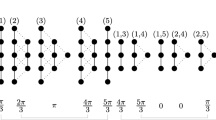Abstract
The finite-size scaling spectra of the spin-1/2XXZ Heisenberg chain with toroidal boundary conditions and an even number of sites provide a projection mechanism yielding the spectra of models with a central chargec < 1, including the unitary and nonunitary minimal series. Taking into account the half-integer angular momentum sectors—which correspond to chains with an odd number of sites—in many cases leads to new spinor operators appearing in the projected systems. These new sectors in theXXZ chain correspond to new types of frustration lines in the projected minimal models. The corresponding new boundary conditions in the Hamiltonian limit are investigated for the Ising model and the 3-state Potts model and are shown to be related to duality transformations which are an additional symmetry at their self-dual critical point. By different ways of projecting systems we find models with the same central charge sharing the same operator content and modular invariant partition function which, however, differ in the distribution of operators into sectors and hence in the physical meaning of the operators involved. Related to the projection mechanism in the continuum there are remarkable symmetry properties of the finiteXXZ chain. The observed degeneracies in the energy and momentum spectra are shown to be the consequence of intertwining relations involvingU q [sl(2)] quantum algebra transformations.
Similar content being viewed by others
References
F. C. Alcaraz, U. Grimm, and V. Rittenberg,Nucl. Phys. B 316:735 (1989).
B. L. Feigin and K. B. Fuchs,Funct. Anal. Appl. 16:114 (1982).
V. Pasquier and H. Saleur,Nucl. Phys. B 330:523 (1990).
F. C. Alcaraz, M. Baake, U. Grimm, and V. Rittenberg,J. Phys. A 22:L5 (1989).
U. Grimm and V. Rittenberg,Int. J. Mod. Phys. B 4:969 (1990).
U. Grimm and V. Rittenberg,Nucl. Phys. B 354:418 (1991).
D. Baranowski, G. Schütz, and V. Rittenberg,Nucl. Phys. B 370:551 (1992).
S. Dasmahapatra, R. Kedem, and B. M. McCoy, preprint ITP-SB 92-11 (1992).
F. C. Alcaraz, M. N. Barber, and M. T. Batchelor,Ann. Phys. (N.Y.)182:280 (1988).
F. C. Alcaraz, M. Baake, U. Grimm, and V. Rittenberg,J. Phys. A 21:L117 (1988).
C. P. Yang,Phys. Rev. Lett. 19:586 (1967).
B. Sutherland, C. N. Yang, and C. P. Yang,Phys. Rev. Lett. 19:588 (1967).
B. M. McCoy and T. T. Wu,Nuovo Cimento Ser. X 56B:311 (1968).
M. Baake, P. Christe, and V. Rittenberg,Nucl. Phys. B 300:637 (1988).
C. J. Hamer and M. T. Batchelor,J. Phys. A 21:L173 (1988).
J. L. Cardy, InPhase Transitions and Critical Phenomena, Vol. 11, C. Domb and J. L. Lebowitz, eds. (Academic Press, New York, 1987).
A. Rocha-Caridi, InVertex Operators in Mathematics and Physics, J. Lepowski, S. Mandelstam, and I. Singer, eds. (Springer, New York, 1985).
D. Friedan, Z. Qiu, and S. Shenker,Phys. Rev. Lett. 52:1575 (1984).
B. Nienhuis, E. K. Riedel, and M. Schick,Phys. Rev. B 27:5625 (1983).
H. Saleur,Phys. Rev. B 35:3657 (1987).
G. v. Gehlen and V. Rittenberg,J. Phys. A 19:L625 (1986).
J. B. Kogut,Rev. Mod. Phys. 51:659 (1979).
P. Chaselon,J. Phys. A 22:2495 (1989).
P. Martin,Potts Models and Related Problems in Statistical Mechanics (World Scientific, Singapore, 1991), and references therein.
D. Levy,Phys. Rev. Lett. 67:1971 (1991).
G. Schütz, Weizmann preprint WIS/92/86/Nov.-PH.
U. Grimm,Nucl. Phys. B 340:633 (1990).
C. N. Yang and C. P. Yang,Phys. Rev. 147:303 (1966);150:321, 327 (1966).
H. W. J. Blöte, J. L. Cardy, and M. P. Nightingale,Phys. Rev. Lett. 56:742 (1986).
I. Affleck,Phys. Rev. Lett. 56:746 (1986).
R. Bulirsch and J. Stoer,Numer. Math. 6:413 (1964).
M. Henkel and G. Schütz,J. Phys. A 21:2617 (1988).
G. Lusztig,Adv. Math. 70:23 (1988).
M. Rosso,Commun. Math. Phys. 117:581 (1988).
G. Lusztig,Contemp. Math. 82:59 (1989).
Author information
Authors and Affiliations
Rights and permissions
About this article
Cite this article
Grimm, U., Schütz, G. The spin-1/2XXZ Heisenberg chain, the quantum algebra Uq[sl(2)], and duality transformations for minimal models. J Stat Phys 71, 923–966 (1993). https://doi.org/10.1007/BF01049955
Received:
Revised:
Issue Date:
DOI: https://doi.org/10.1007/BF01049955



